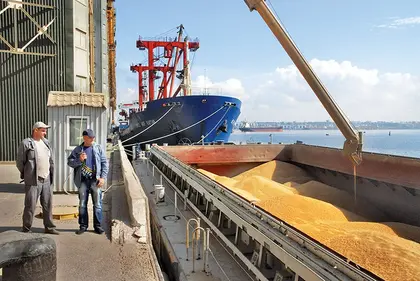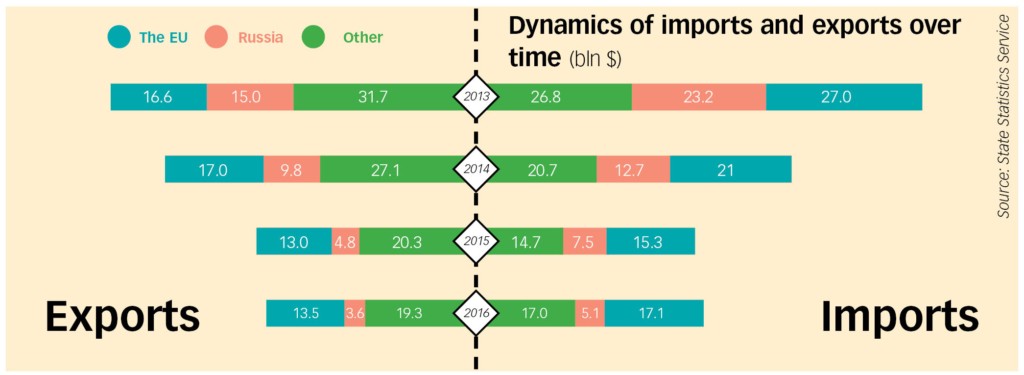As Russia’s war rages on against Ukraine’s eastern industrial Donbas region, steel and chemical exports continue to take a hit. But as these big commodity exports whither, the country’s agricultural exports, and especially grain, are showing renewed spurts of growth. Ukraine’s grain exports increased to 40.2 million tons in the 2015–2016 marketing year, which runs from July to June next year, up from 32.3 million tons in the 2013–14 marketing year.
Ukraine’s grain exports increased to 40.2 million tons in the 2015–2016 marketing year, which runs from July to June next year, up from 32.3 million tons in the 2013–14 marketing year.
JOIN US ON TELEGRAM
Follow our coverage of the war on the @Kyivpost_official.
Better still, Ukraine’s grain industry has the potential to boost exports to 60 million tons within the next three to four years — if the country’s transport logistics are improved.
Big exporters
Ukraine is one of the world’s top 10 largest grain producers, and is also a leading maize exporter. Last year the country produced a total of 66.1 million tons of grain, and grain producers earned $6.1 billion from exporting 40.2 million tons of grain.
“Thanks to a consistently high grain harvest, our country over the last five years has almost tripled its grain exports — from 14 million tons in 2011 to 40.2 million tons in 2016,” says Yuriy Lupenko, director of the National Scientific Center Institute of Agrarian Economics in Kyiv.
In Ukraine, 37,400 companies are currently involved in grain production. The country’s main grain exporters are domestic companies Nibulon, Kernel, the State Food & Grain Corporation of Ukraine and multinational grain producers Louis Dreyfus, Bunge and Cargill. These “big six” grain exporters account for about 30 percent of the country’s grain exports.
In 2016, Ukrainian agricultural exports accounted for 12 percent of the country’s gross domestic product of $93.26 billion. About 39.6 percent of Ukraine’s agricultural exports were grain, and last year’s $6.1 billion in earnings from grain exports accounted for 17 percent of the country’s total export revenues of $36.4 billion.
During the last marketing year, Ukraine exported 40.2 million tons of grain, up from 37.4 million tons in 2014–2015, according to figures from the Economy Ministry.
And grain exports are expected to keep rising. In the first quarter, the country’s grain exports were worth $4.6 billion, up by 38 percent year-on-year.
Nataliya Shpyhotska, a senior analyst at Dragon Capital, Ukraine’s leading investment bank, expects 10 percent growth in grain exports when the 2016–2017 marketing year is over in June.
New markets
In early 2014, following Russia’s annexation of Crimea and the start of its war against the Donbas, Ukraine’s steel and coal exports suffered, leaving agriculture as the country’s foremost exporting sector.
In the 2015–2016 marketing year, the main importers of Ukrainian grain products were African, Asian and European Union countries. Egypt remained the top export destination for Ukrainian grain last year, taking 4.98 million tons, a rise of 275,000 tons on the previous year. Altogether, the country imported 12.4 percent of Ukraine’s total grain exports.
Spyhotska of Dragon Capital says that, in the 2015–2016 marketing year, Egypt was also the largest importer of Ukrainian wheat, taking a 16 percent share, while Thailand and Indonesia were second and third, with 13 percent and 10 percent shares respectively.
The largest importers of Ukrainian maize last year were Spain, accounting for 17 percent of Ukraine’s total exports, China (15 percent), Egypt (13 percent), Italy (10 percent) and the Netherlands (8 percent).
Ukraine’s largest barley importers were Saudi Arabia with a 53 percent share, China (16 percent) and Libya (10 percent).
Moroccan grain imports may increase this year because of a bad harvest there. This year its grain imports may be between five and 5.5 million tons, of which Ukraine should supply about 10 percent — Ukraine usually exports to Morocco nearly 500,000 tons of wheat annually.
Experts also believe that Asian countries could be a good target for Ukrainian grain exporters.
In 2016, Ukraine increased its grain exports to Indonesia by 1,140 tons on the year, to 2.1 million tons, while to India they totaled 2 million tons last year against just 5,700 tons in 2015. Exports to Iran rose by 1.27 million tons to 1.94 million tons, and those to Bangladesh were up by 1 million tons, to 1.93 million tons.
In 2016, Ukraine slightly reduced its grain exports to Saudi Arabia, the United Arab Emirates and Kuwait, but experts believe these remain promising markets for Ukrainian grain products, as Ukraine could fully satisfy the demand for grain in these countries.
Meanwhile, the Chinese and Japanese markets have been weaker.
Ukrainian exports to China decreased in 2016 to 2.98 million tons, which is 21,000 tons less than in 2015. Last year Ukrainian grain deliveries to Japan nearly halved, to 233,000 tons in 2016 compared with the previous year.
However, in 2016, Ukraine supplied South Korea with about a quarter of its wheat needs — mainly fodder grain, and growing demand in South Korea could mean it imports more from Ukraine in future years.
In fact, Ukraine is just starting to blaze a trail into the Asian grain markets. Provided it promotes its exports, and there are favorable market conditions, Ukraine has the potential to export to Asian nearly $10 billion worth of grain annually, experts say.
EU market
With its relative proximity to major markets in the Middle East, North Africa and Europe, Ukraine is well-placed to make competitive grain exports to these markets, due to lower transport costs.
Moreover, since the introduction on Jan. 1, 2016 of Ukraine’s free trade agreement with the European Union, a portion of its grain exports to the union can be made duty free. Under its quota, Ukraine can export to the EU 1.6 million tons of grain in 2016, and the quotas will increase to 2 million tons over the next five years.
In 2016, Ukraine exported to the EU grain worth $1.3 billion — 6.7 million tons of corn and 1.3 million tons of wheat.
After the quotas stipulated in the free trade agreement with the EU are exhausted, exports of certain goods are conducted under the common rules of trade with the EU.
Last year, Ukraine early exhausted its quotas for wheat, maize and barley grains duty-free exports to the EU.
In 2016, Ukraine exported under quote 400,000 tons of corn, 6,300 tons of barley groats, 950,000 tons of soft wheat, 250,000 tons of barley, and 4,000 tons of oats.
Ukraine has repeatedly raised the question of increasing its EU grain export quotas. In May, some progress was made when the relevant committee of the European parliament voted in favor of an expansion of the duty-free exports for Ukraine, but the decision did not apply to wheat.
“Tomatoes, wheat and urea (raw material for fertilizers) should not enjoy quota preferences further to those outlined in the Deep and Comprehensive Free Trade Area (DCFTA),” a report on the European Parliament news website reads.
In 2017, Ukraine is allowed to export to the EU450,000 tons of corn and corn meal, 6,500 tons of barley groats and flour, 960,000 tons of soft wheat and wheat flour, 270,000 tons of barley and barley flour, and 4,000 tons of oats.
Shpyhotska of Dragon Capital says the EU’s reluctance to increase quotas for wheat and barley is due to the competition EU producers are facing on the international markets.
“Ukraine competes with the EU on the international market, which is why EU wants to protect European (wheat and barley) producers (by not increasing quotas for Ukrainian products),” she said.
“But certainly, the expansion of quotas would contribute to an increase in exports, and it’s reasonable to work for that,” Lupenko added.
Problems and prospects
Still, to increase its grain exports over the next few years Ukraine will not only have to compete on the international markets, but also improve its infrastructure — currently the main obstacle to increasing grain exports, analysts say.
“The main problem just now is infrastructure,” says Mykola Gorbachov, president of the Ukrainian Grain Association, adding that producers and exporters have problems delivering grain to seaports because of railway infrastructure. There is a shortage of grain cargo wagons and locomotives, wagons are worn out, and there are shortages of diesel fuel and spare parts.
The shortage of cargo wagons in Ukraine is estimated at 4,000–5,000 rail cars. Their number is falling, despite the fact that the share of railway transportation in grain exports is 65 percent. “Ukrzaliznytsia refuses to produce new wagons, and this prevents production growth and therefore export growth,” says Gorbachov.
But experts say that if the problem with rail infrastructure is resolved, grain exports could rise by 20 million tons.
“Assuming that the logistics problem is resolved, then within the next three to four years Ukraine could export up to 60 million tons of grain (against 40.2 million tons today),” Gorbachov says.
Klympush-Tsintsadze: Ukraine catching up in bringing standards in line with EU trade pact
Ukrainian Vice Prime Minister for European and Euro-Atlantic Integration Ivanna Klympush-Tsintsadze said in May that Ukrainian was behind in implementing the Deep and Comprehensive Free Trade Area as part of the nation’s association agreement with the European Union. At the time, she said Ukraine had pass only 26 of expected 130 acts of the EU law into its legislation. But she told the Kyiv Post on June 12 that the nation has made progress. “Now the numbers are better,” she said. “We have passed quite a few important pieces of legislation and secondary legislation as well.”
You can also highlight the text and press Ctrl + Enter






